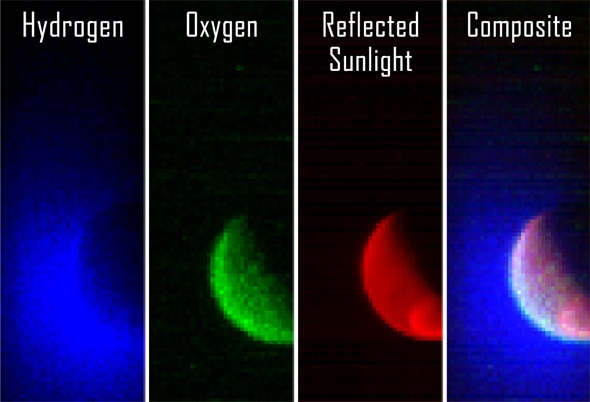Create a free profile to get unlimited access to exclusive videos, sweepstakes, and more!
MAVEN’s Mars

As I write this, India’s Mars Orbiter Mission has been orbiting the red planet for just about a day, and NASA’s MAVEN for only three. I haven’t seen any images from MOM yet (UPDATE: see below), but the Mars Atmosphere and Volatile Evolution spacecraft took ultraviolet images just eight hours after achieving orbit, and they’re breathtaking.
Mars has an atmosphere, thin, but there. And it has different components to it, seen in different wavelengths (colors) of UV light.
Hydrogen is the lightest element, and extends the farthest off the planet. Shown here colored blue (representing the shortest wavelength of UV), you can see it extends well off the planet’s surface (Mars is 6,800 kilometers—4,200 miles—across, for scale). Oxygen (in green) is heavier, and sticks closer. There isn’t much of it on Mars, and what there is comes from water (which is where the hydrogen originates as well) and carbon dioxide. I suspect the crescent pattern is due to limb brightening; near the edge of the planet we’re looking through more atmosphere, so the oxygen emission is more apparent there.
The red panel is reflected sunlight, and you can see a brighter ring near the pole that is either from clouds—Mars has those too, though very thin—or ice. The panel on the far right is the composite of all three images, an amazing portrait of our neighbor.
I literally sighed in amazement when I saw there; they’re lovely and fascinating and just so odd. Mars is such a weird little world.
But weird is in the eye of the beholder. MAVEN will orbit Mars and take scientific observations for at least a year, and we’ll get to learn quite a bit about the atmosphere of the planet as it does. Mars used to have thicker air and plenty of water; now they’re both almost all gone. Why? Why did Mars evolve so differently than Earth? We know it has to do with Mars not having a strong magnetic field as we do, so the solar wind was able to merciless strip away its air over the eons. But our understanding of the details is still lacking. That’s what we sent MAVEN to find out.
And it joins so many other probes currently examining Mars—including MOM, which I haven’t written much about, but of course Emily Lakdawalla at the Planetary Society has a fantastic article about it. There’s still so much to explore on Mars. And above it. Soon, we’ll have a more complete picture of it, and hopefully understand why, but for the whim of nature, go we.
Update, Sept. 25, 2014 at 14:00 UTC: Of course, between the time I wrote this article last night and the time it posted this morning, MOM released two great shots of Mars. The first shows a view of windswept craters over a bicolored landscape:
The gray is due to dark basaltic rock, and the red from where the surface is covered in dust rich in iron oxide—rust.
The second shot shows the limb of Mars:
I love the caption posted from the MOM Twitter account: "A shot of Martian atmosphere. I'm getting better at it. No pressure."
I'm very excited to see what else India's first interplanetary mission has in store for us!


























